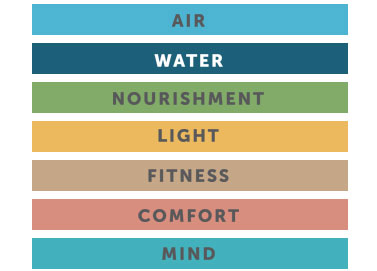|
|
|
The RED Letter
RED Engineering & Design
|
|
|
|
|
|
 |
|
More videos in the fall!
We are getting ready to add three more videos to our series Engineering-in-a-Box. These will be fun, too, and chocked full of good information. The first video in the second series is planned for release in the fall.
|
 |
WELL
A certification gaining momentum
Those in our industry are, no doubt, familiar with the U.S. Green Building Council (USCBC) and their Leadership in Energy & Environmental Design (LEED) certifications. Well, there is another certification that is gaining momentum in the building industry: the  WELL Building Standard. Administered by the International WELL Building Institute (IWBI), created by Delos, a wellness real estate entity, IWBI worked with the USGBC's Green Building Certification Institute (GBCI) to develop building wellness standards. WELL standards are intended to complement LEED standards. WELL Building Standard. Administered by the International WELL Building Institute (IWBI), created by Delos, a wellness real estate entity, IWBI worked with the USGBC's Green Building Certification Institute (GBCI) to develop building wellness standards. WELL standards are intended to complement LEED standards. In short, building wellness standards are broken down into seven concept categories: air, water, nourishment, light, fitness, comfort, and mind. For example, the air standard requires that air within a building meet certain performance criteria using specified protocols, practices, technologies, building/furniture materials, and cleaning products. The goal is to lessen health impacts associated with such things as upper respiratory infections, allergies, chronic fatigue, and eye irritations--to name a few. The other six categories have similar performance standards and requirements.  The certification process requires several steps. Among them, a building must receive a passing score on each of the seven concepts in accordance with the WELL Building Standards. Then, there is project documentation and data submission followed by a site audit (performance verification) from an IWBI official. Similar to LEED certification, the WELL Building certification has levels, too. WELL-certified buildings are submitted for Blue, Silver, or Gold certifications based on their respective compliance with "precondition, treatment, and optimization." Fees range from $1,500 to $10,000 for registration and $4,000 to $7,500+ for certification. Performance verification fees start at ~$9,000. WELL certification is valid for three years and re-certification fees start at $1,450. For more information log on to http://www.wellcertified.com/
|
|
|
September 24-26: AIA NC 2015 Design Conference - Durham, NC
|
|
About the masthead image:
Raleigh Charter High School, Raleigh, NC - Stairs and railing structural engineering design by RED Engineering & Design.

|
|
|
|
 |
|
Green Globes
An alternate certification
Speaking of certifications, the LEED certification has been under scrutiny for "not living up to" their certification levels. In one of several, a study involving eleven Navy facilities demonstrated that four LEED-certified buildings performed more poorly on energy savings than those not LEED-certified and four others had only slightly better energy performance. 
While the General Services Administration (GSA) mandates that all its buildings must be LEED certified, the GSA has recommended that other federal agencies can select an alternate certification known as Green Globes. Similar to LEED in many of its requirements, Green Globes is an online tool used to rate and certify green buildings. Its modules include new construction/significant renovations, office fit-ups, and existing buildings (offices, multi-residential, retail, health care, and light industrial.)
The certification is "structured as a self-assessment" and is performed in-house by a project manager and design team. It uses the integrated design process that includes everything from construction drawings, stormwater management, and landscape design to building life-cycle cost analysis and building commissioning.
The Green Globes certification grew out of the Building Research Establishment Environmental Assessment Methodology (BREEAM) devised in the 1980s by the United Kingdom. In the mid-1990s, BREEAM Canada formulated the Green Globes for Existing Buildings and in 2004 the system was adapted for the United States. The system is based mainly on ASHRAE standards and ANSI/GB 01-2010: Green Building Assessment Protocol for Commercial Buildings.
As for certification costs, there are registration, assessor, and certification fees based on building type. Quotes are given based on submitted information.
For more information, log on to`` https://www.thegbi.org/green-globes-certification/
|
 |
|
Our canine graduate
Turks
Many of you may know that Red Engineering and Design is a dog-friendly office and that last year, our intern, Stephen, was fostering and preparing a young Labrador for service school. We are pleased and happy to report that Turks graduated from guide-dog school with flying colors and has been placed with his new sight-impaired owner. His new owner is thrilled and Turks loves his new job!

|
|
|
|
|